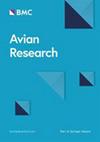How nestlings of Oriental Reed Warbler respond to adult alarm calls
IF 1.7
2区 生物学
Q1 ORNITHOLOGY
引用次数: 0
Abstract
Avian alarm calls mediate defenses against brood parasites and predators. These calls facilitate communication among adults and alert nestlings to potential danger. While heterospecific call recognition has been extensively studied in adult birds, nestlings—lacking direct predation experience and heterospecific alarm exposure—represent an ideal system to investigate the response to interspecific warning cues. This study explored the recognition capabilities of 5–6-day-old nestlings in Oriental Reed Warbler (Acrocephalus orientalis), a common host of the Common Cuckoo (Cuculus canorus). We exposed the nestlings to playbacks of alarm calls directed at parasites and raptors from conspecific, Vinous-throated Parrotbill (Sinosuthora webbiana, sympatric species), Isabelline Shrike (Lanius isabellinus, allopatric species) and Common Tailorbird (Orthotomus sutorius, allopatric species) adults. Results indicated that there was no significant difference in the responses of nestlings to the alarm calls of conspecific and allopatric adults directed at cuckoos and sparrowhawks. In addition, interestingly, nestlings significantly reduced their begging in response to conspecific and unfamiliar allopatric Isabelline Shrike and Common Tailorbird alarm calls but exhibited a weak response to the sympatric Vinous-throated Parrotbill. Whether older warbler nestlings with more social experience exhibit stronger responses to the alarm calls of Vinous-throated Parrotbill adults requires further investigation.

东方苇莺的雏鸟对成年鸣叫有何反应
鸟类的警报呼叫调解了对幼虫寄生虫和捕食者的防御。这些叫声有助于成年企鹅之间的交流,并提醒雏鸟注意潜在的危险。虽然异种鸣叫识别已经在成年鸟类中得到了广泛的研究,但缺乏直接捕食经验和异种警报暴露的雏鸟是研究对种间警告信号反应的理想系统。本研究探讨了普通杜鹃(Cuculus canorus)常见寄主东方芦莺(Acrocephalus orientalis) 5 - 6日龄雏鸟的识别能力。我们对雏鸟播放同种的、同域种的毒喉鹦鹉(Sinosuthora webbiana)、异域种的伊莎伯罗鸟(Lanius isabellinus)和异域种的普通缝叶鸟(Orthotomus sutorius)成虫对寄生虫和猛禽的报警叫声。结果表明,雏鸟对同种和异域成鸟对杜鹃和雀鹰的鸣叫反应无显著差异。此外,有趣的是,雏鸟对同种和陌生的异域伊莎伯劳鸟和普通斑胸草鸟的警报呼叫的反应显著减少,但对同域的酒喉鹦鹉的反应较弱。是否有更多社会经验的成年莺雏鸟对成年红喉鹦鹉的警报反应更强烈,还需要进一步的研究。
本文章由计算机程序翻译,如有差异,请以英文原文为准。
求助全文
约1分钟内获得全文
求助全文
来源期刊

Avian Research
ORNITHOLOGY-
CiteScore
2.90
自引率
16.70%
发文量
456
审稿时长
46 days
期刊介绍:
Avian Research is an open access, peer-reviewed journal publishing high quality research and review articles on all aspects of ornithology from all over the world. It aims to report the latest and most significant progress in ornithology and to encourage exchange of ideas among international ornithologists. As an open access journal, Avian Research provides a unique opportunity to publish high quality contents that will be internationally accessible to any reader at no cost.
 求助内容:
求助内容: 应助结果提醒方式:
应助结果提醒方式:


